9+ Inauguration Speech Examples to Download
Elections are a very stressful and overwhelming time for most people. It is the time when the right to suffrage is practiced by the people in order to vote for the candidates they think are worthy of the positions they run for. Not only that, the results of the elections will help determine the future of state, town, and most especially the whole country. It is a very significant and one of the most important days when people have to decide on what and who will be good for the whole state and country.
During the elections period, you need to choose the candidate that best stands for what you believe is just and right. After a certain period intended for the candidates’ campaigns, the election day immediately follows. During the exact date for the election, you go to your poll, fill out your ballot, and put it the ballot box; you have officially cast your vote. Then what happens? After all the votes are counted, and the winning candidates are announced, an inauguration then follows. You often hear the word inauguration on election period. But what does that really mean and what does this entail?

What Happens on Inauguration Day?
By definition, inauguration means the beginning or introduction of a system, policy, or period; the formal admission of someone to office, or a ceremony to mark the beginning of something. During election period, inauguration is a formal ceremony wherein an elected public official begins his/her term of office. Although the word is commonly used and associated with elections, it can also mean the opening or first public use of a new civic area, organization, or project such as new library, museum, hospital, etc. Simply put, inauguration pertains to a new beginning, be it about people in office or newly opened buildings or infrastructures.
Since the inauguration day during the election period is the most common example, you should know what happens during the said event in the USA. On the exact date of the scheduled inauguration day, it starts with a morning worship service. The morning worship service is a tradition during such a monumental day that started in 1993 with Franklin D. Roosevelt and his first lady Eleanor; they attended church at St. John’s Episcopal Church near the White House. It has then set a precedent that has been diligently followed by all the other newly elected high officials of the country.
After the morning worship service, the procession to the Capitol follows. Although there have been changes with the vehicles used during the procession, this has been a tradition since the inauguration of George Washington in 1789 to have the president-elect, the vice president-elect and their spouses proceed to the swearing-in ceremony in the White House. They are escorted by the Joint Congressional Committee on Inaugural Ceremonies (JCCIC). It is an iconic procession that leads to the grounds where the newly elected president and vice president of the country will take their oath.
The vice president’s swearing-in ceremony is immediately conducted once the procession arrives at the White House. This is when the vice president takes his/her oath of office. According to the U.S. constitution, the vice president doesn’t have a specific oath unlike that of the president. There has been quite a few officials who have administered the vice president’s oath. After this follows the president’s swearing-in ceremony where the chief justice of the Supreme Court administers the president’s oath. Some past inaugurations were held in front of New York’s Federal Hall and in Philadelphia like that of George Washington’s swearing-in ceremony, It wasn’t until 1801 when the swearing-in ceremony move to its current location in Washington, DC.
After all the swearing-in of the highest ranking elected official, the inaugural address follows. The tradition of giving an inauguration address began with George Washington with the shortest inauguration speech on record with only 135 words for his entire speech. However, the tradition many early presidents delivered their address before taking oath, the proceeding has been changed and the speech follows the oath. After the speech, the outgoing president and his spouse departs from the White House to proceed on their post-presidential lives. In the past, previous presidents leave the Capitol a day or two before the oath of the incoming president. But on the current days, incoming presidents and vice presidents have escorted the previous officials following the swearing-in ceremony.
After all the public appearances portion of the inauguration day, it has also been a tradition to hold an inauguration luncheon hosted by the JCCIC for the president, vice president, their spouses and other dignitaries. Following the luncheon, the newly elected president and vice president proceeds to Pennsylvania Avenue to the White House as a procession of ceremonial military regiments, citizens’ groups, marching bands, and floats follow. After the inaugural parade, a tradition inaugural ball follows. The tradition for the inaugural ball began in 1809 with James Madison’s inauguration.
As you may have noticed, there is a strict procedure that needs to be followed when it comes to the inauguration day. Although there have been changes, the same steps however in different order are still followed up to this day.
Washington’s First Inaugural Address Example
JFK Inaugural Address Example
Reagan’s Inaugural Speech Example
Thomas Flynn Inauguration Speech Example
Lincoln’s Second Inaugural Address Example
How to Craft an Inaugural Speech
An inauguration speech can either leave the audience inspired and in awe or leave them bored and uninspired. As you may now know based on the discussion above, the highest ranking elected official delivers the inauguration speech where he/she can set the tone of the presidency. However, making these speeches is not an easy feat. To help you with crafting your own inspirational inauguration speech, an easy guide is provided below:
1. Choose an appropriate greeting for your audience
The greeting of your speech should set the tone for your entire speech. You should be able to open the speech warmly and let your audience feel as if they are a part of the momentous celebration. There are a couple of ways you can open the speech. It can be done through saying a quote, using a “what if” or “imagine” scenario, ask a question, use statistics, use statement or phrase, and so on. You should make the audience feel that you are as excited and as happy as they are with the celebration.
Here are some examples of inaugural speech greetings by previous US presidents:
- “I ask you to share with me today the majesty of this moment. In the orderly transfer of power, we celebrate the unity that keeps us free.” —Richard M. Nixon, 1969
- “For myself and for our nation, I want to thank my predecessor for all he has done to heal our land.” —Jimmy Carter, 1977
- “Today we celebrate the mystery of American renewal. This ceremony is held in the depth of winter, but by the words we speak and the faces we show the world, we force the spring, a spring reborn in the world’s oldest democracy that brings forth the vision and courage to reinvent America.” —Bill Clinton, 1993
2. Describe the state of the nation
In this part of the speech you should remind the people of the current state of the nation. However, that does not mean you only include all the negative, also give emphasis on the positive things that have happened in the nation. This will help you set the tone for your term; if you feel like the negative outweighs the positive, then bring focus to that. Let the audience get in touch of the actual happenings of the present. Let them understand that the nation has still so much to improve on that way you can invoke them to do something about it together with you.
3. Pick a relevant issue and lay out your presidential plan
Although there will always be a lot of issues going on at the same time, as they say, you have to pick your battles. You have to know what your people want you to prioritize. Pick the issue you know the people have been wanting change for quite a while. Once you know what you have to work on, you set your plans on how to resolve the issue. And in your speech, express your presidential plans or the platforms you have ever since the campaign periods. Make the people know you are serious and determined to solve the issue be it about poverty, war, foreign policy, equality, and so on.
4. Inspire your audience
After you remind the people of the difficulties your nation is battling with, you need to give them hope that everything will be all right, that you will give your all in order to solve the current issues you country is facing. Aside from that, you need to inspire them to do their part, inspire them to give you a hand to resolve such matters. Inspire them to be better and responsible citizens of the country. You can use a quote, a strong phrase, or post a challenge to effectively get your point across.
5. Close your speech
If you think you have discussed or mentioned all the important points, you have to formally end you speech. And although it’s the end of the speech, let them know that you are still with them and you will fight their battles with them.
- “I am loath to close. We are not enemies, but friends. We must not be enemies. Though passion may have strained it must not break our bonds of affection. The mystic chords of memory, stretching from every battlefield and patriot gave to every living heart and hearthstone all over this broad land, will yet swell the chorus of of the Union, when again touched, as surely as they will be, by the better angels of our nature.” —Abraham Lincoln, 1861
- “Let it be said by our children’s children that when we were tested, we refused to let this journey end; that we did not turn back, nor did we falter. And with eyes fixed on the horizon and God’s grace upon us, we carried forth that great of freedom and delivered it safely to future generations. Thank you. God bless you, and God bless the United States of America.” —Barack Obama, 2009
University President Inaugural Speech Example
Attorney General Inaugural Remarks Example
Ben Franklin Inaugural Speech Example
CMA Incoming President Inaugural Speech Example
9+ Inauguration Speech Examples to Download
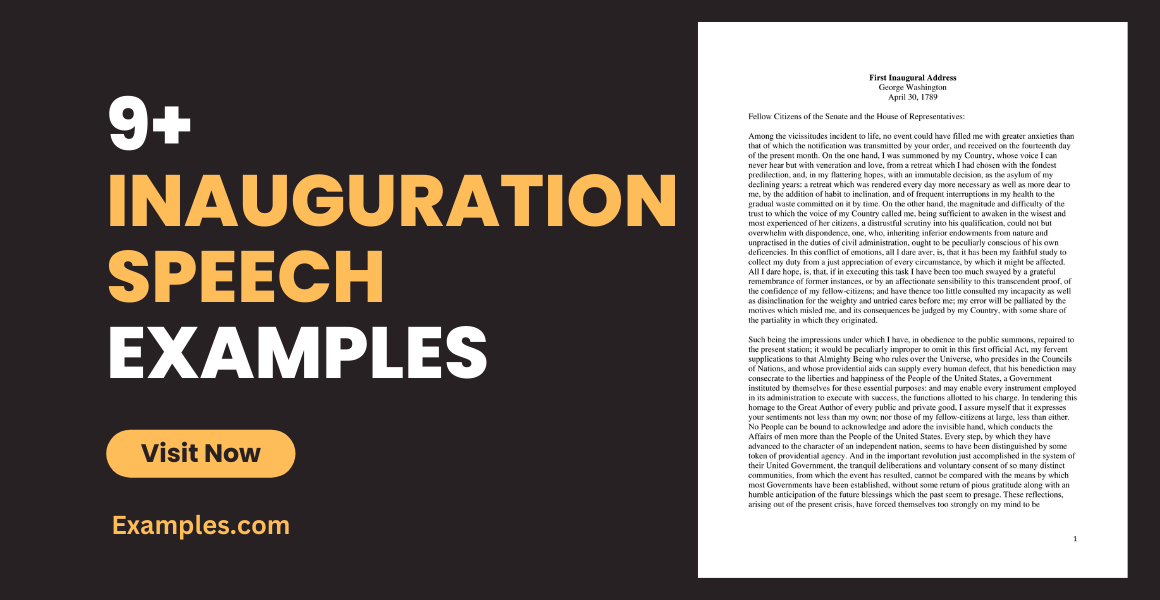
Elections are a very stressful and overwhelming time for most people. It is the time when the right to suffrage is practiced by the people in order to vote for the candidates they think are worthy of the positions they run for. Not only that, the results of the elections will help determine the future of state, town, and most especially the whole country. It is a very significant and one of the most important days when people have to decide on what and who will be good for the whole state and country.
During the elections period, you need to choose the candidate that best stands for what you believe is just and right. After a certain period intended for the candidates’ campaigns, the election day immediately follows. During the exact date for the election, you go to your poll, fill out your ballot, and put it the ballot box; you have officially cast your vote. Then what happens? After all the votes are counted, and the winning candidates are announced, an inauguration then follows. You often hear the word inauguration on election period. But what does that really mean and what does this entail?

What Happens on Inauguration Day?
By definition, inauguration means the beginning or introduction of a system, policy, or period; the formal admission of someone to office, or a ceremony to mark the beginning of something. During election period, inauguration is a formal ceremony wherein an elected public official begins his/her term of office. Although the word is commonly used and associated with elections, it can also mean the opening or first public use of a new civic area, organization, or project such as new library, museum, hospital, etc. Simply put, inauguration pertains to a new beginning, be it about people in office or newly opened buildings or infrastructures.
Since the inauguration day during the election period is the most common example, you should know what happens during the said event in the USA. On the exact date of the scheduled inauguration day, it starts with a morning worship service. The morning worship service is a tradition during such a monumental day that started in 1993 with Franklin D. Roosevelt and his first lady Eleanor; they attended church at St. John’s Episcopal Church near the White House. It has then set a precedent that has been diligently followed by all the other newly elected high officials of the country.
After the morning worship service, the procession to the Capitol follows. Although there have been changes with the vehicles used during the procession, this has been a tradition since the inauguration of George Washington in 1789 to have the president-elect, the vice president-elect and their spouses proceed to the swearing-in ceremony in the White House. They are escorted by the Joint Congressional Committee on Inaugural Ceremonies (JCCIC). It is an iconic procession that leads to the grounds where the newly elected president and vice president of the country will take their oath.
The vice president’s swearing-in ceremony is immediately conducted once the procession arrives at the White House. This is when the vice president takes his/her oath of office. According to the U.S. constitution, the vice president doesn’t have a specific oath unlike that of the president. There has been quite a few officials who have administered the vice president’s oath. After this follows the president’s swearing-in ceremony where the chief justice of the Supreme Court administers the president’s oath. Some past inaugurations were held in front of New York’s Federal Hall and in Philadelphia like that of George Washington’s swearing-in ceremony, It wasn’t until 1801 when the swearing-in ceremony move to its current location in Washington, DC.
After all the swearing-in of the highest ranking elected official, the inaugural address follows. The tradition of giving an inauguration address began with George Washington with the shortest inauguration speech on record with only 135 words for his entire speech. However, the tradition many early presidents delivered their address before taking oath, the proceeding has been changed and the speech follows the oath. After the speech, the outgoing president and his spouse departs from the White House to proceed on their post-presidential lives. In the past, previous presidents leave the Capitol a day or two before the oath of the incoming president. But on the current days, incoming presidents and vice presidents have escorted the previous officials following the swearing-in ceremony.
After all the public appearances portion of the inauguration day, it has also been a tradition to hold an inauguration luncheon hosted by the JCCIC for the president, vice president, their spouses and other dignitaries. Following the luncheon, the newly elected president and vice president proceeds to Pennsylvania Avenue to the White House as a procession of ceremonial military regiments, citizens’ groups, marching bands, and floats follow. After the inaugural parade, a tradition inaugural ball follows. The tradition for the inaugural ball began in 1809 with James Madison’s inauguration.
As you may have noticed, there is a strict procedure that needs to be followed when it comes to the inauguration day. Although there have been changes, the same steps however in different order are still followed up to this day.
Washington’s First Inaugural Address Example
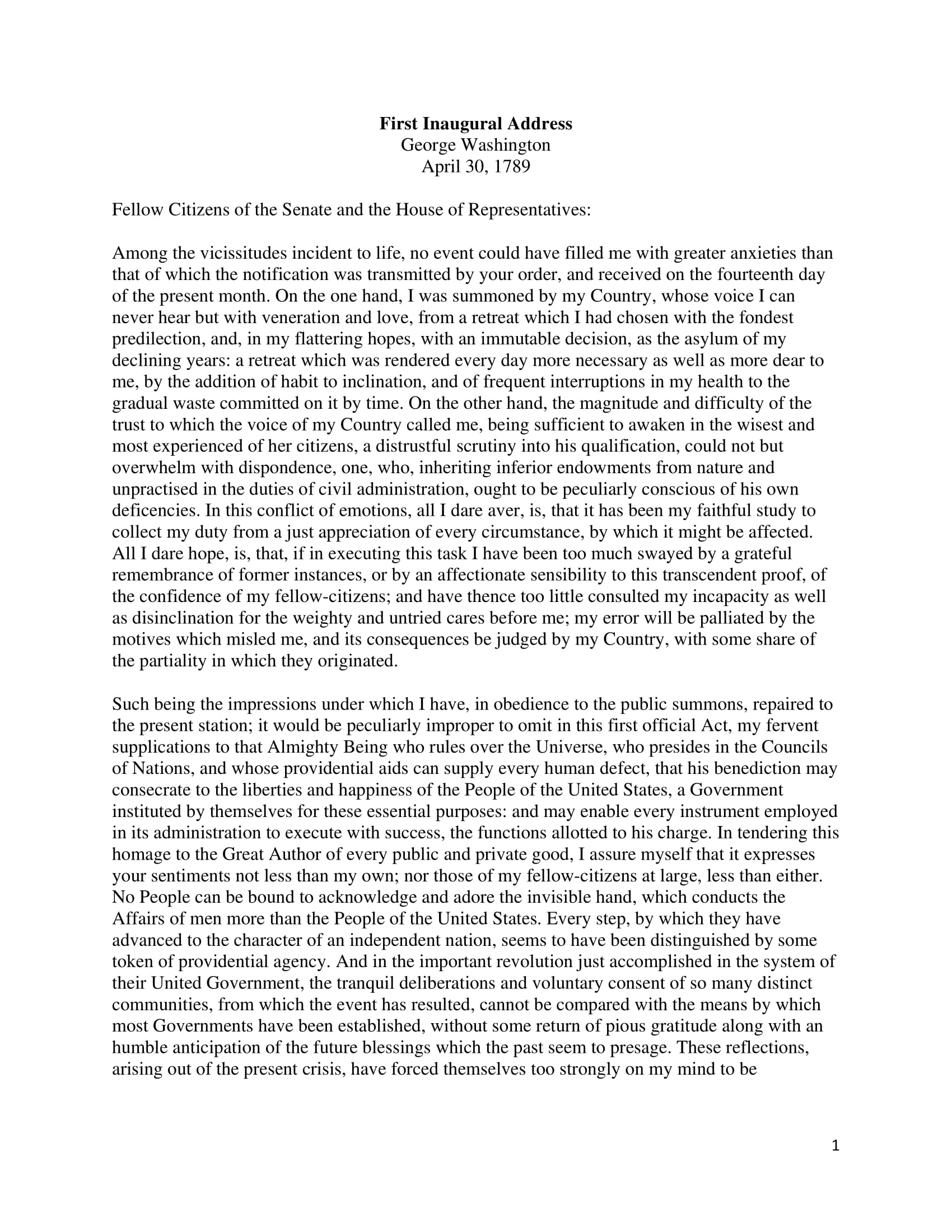
morganhighhistoryacademy.org
Details
File Format
PDF
Size: 438 KB
JFK Inaugural Address Example
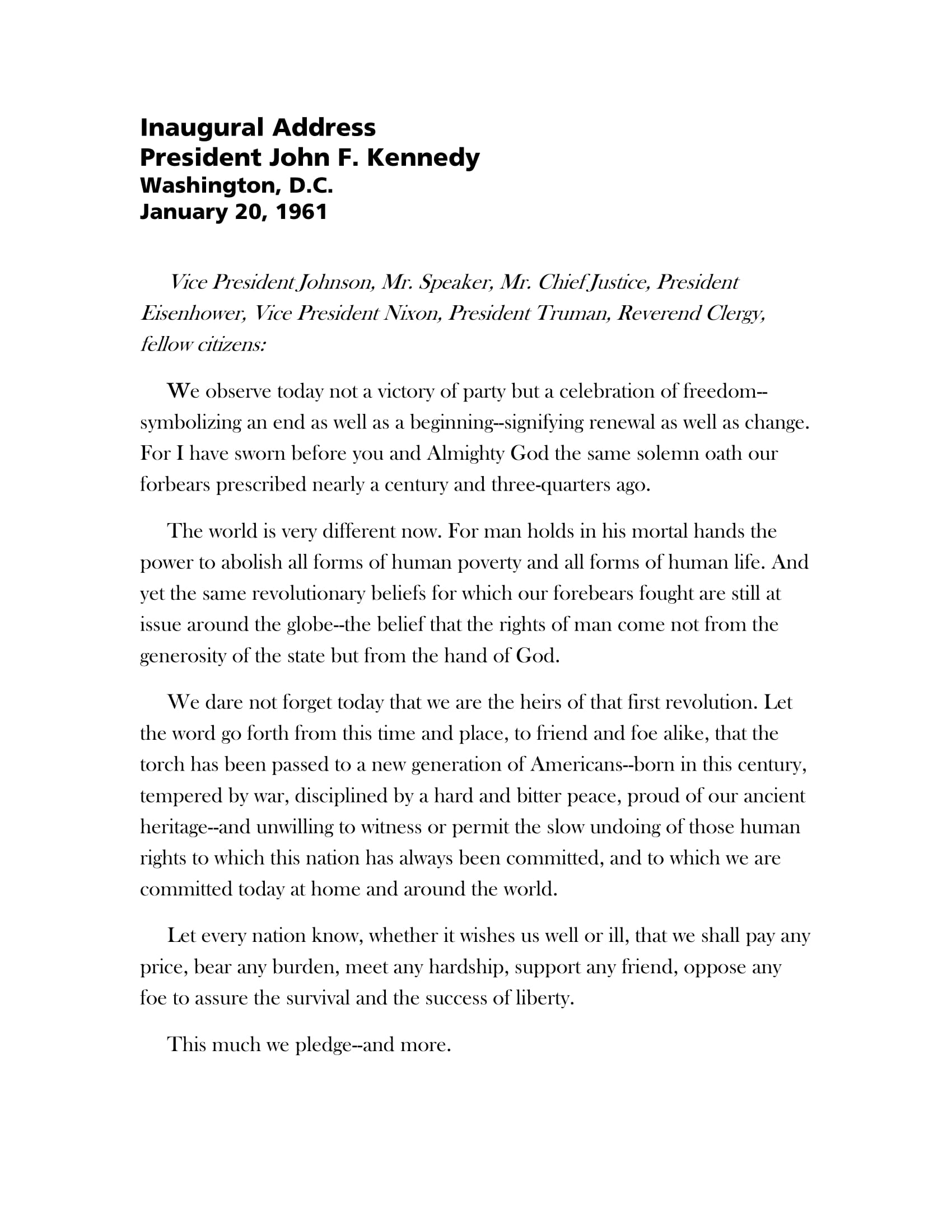
nps.gov
Details
File Format
PDF
Size: 243 KB
Reagan’s Inaugural Speech Example

lsrhs.net
Details
File Format
PDF
Size: 355 KB
Thomas Flynn Inauguration Speech Example
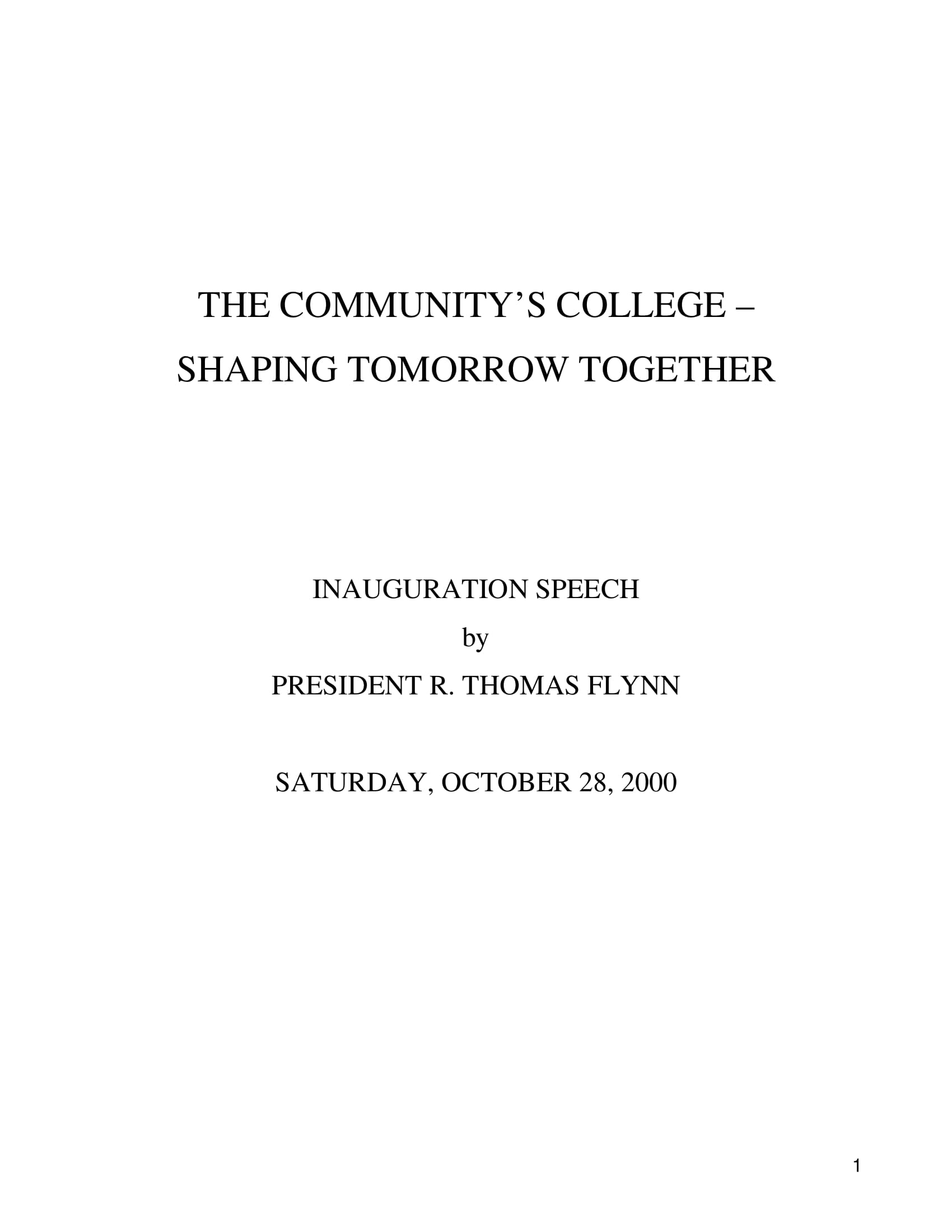
monroecc.edu
Details
File Format
PDF
Size: 62 KB
Lincoln’s Second Inaugural Address Example
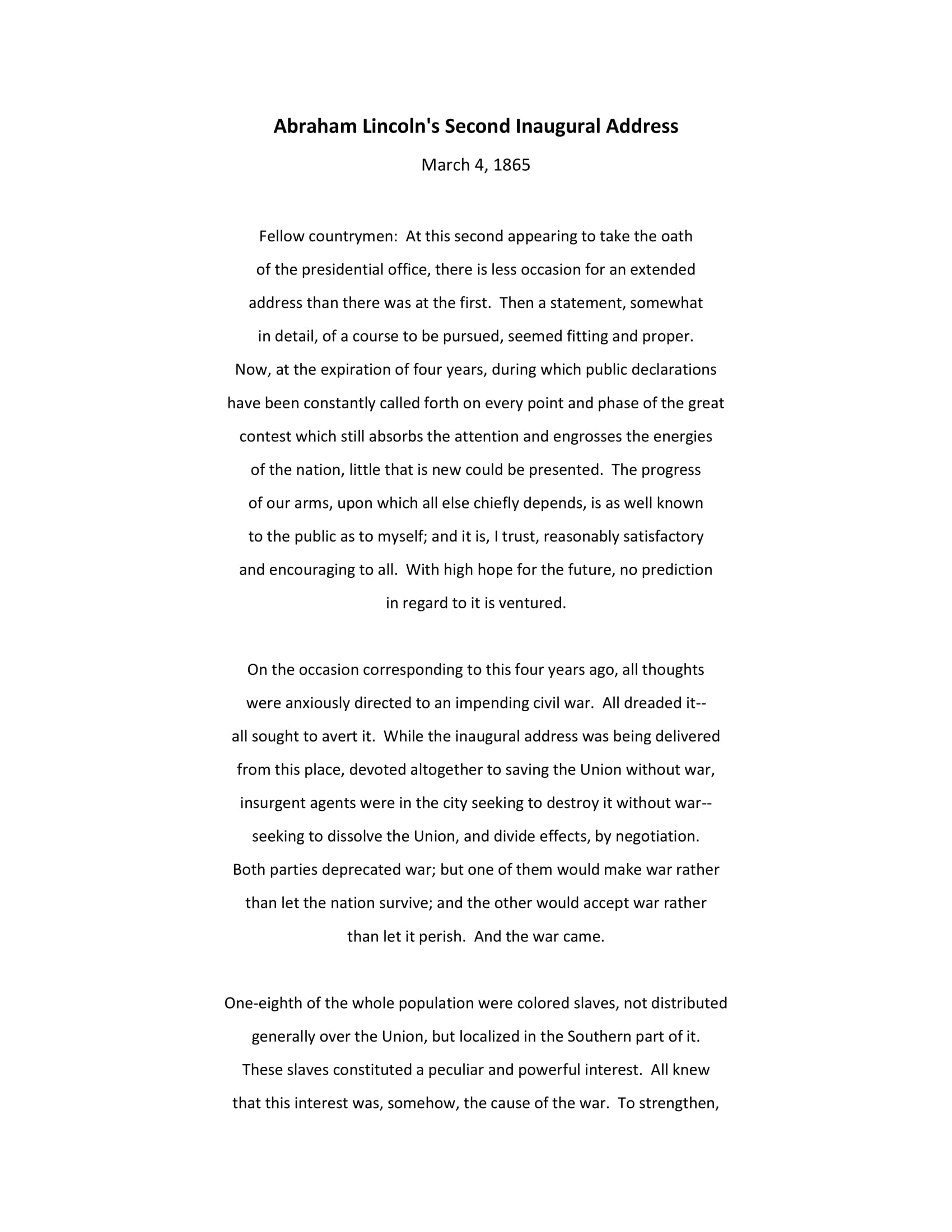
battlefields.org
Details
File Format
PDF
Size: 191 KB
How to Craft an Inaugural Speech
An inauguration speech can either leave the audience inspired and in awe or leave them bored and uninspired. As you may now know based on the discussion above, the highest ranking elected official delivers the inauguration speech where he/she can set the tone of the presidency. However, making these speeches is not an easy feat. To help you with crafting your own inspirational inauguration speech, an easy guide is provided below:
1. Choose an appropriate greeting for your audience
The greeting of your speech should set the tone for your entire speech. You should be able to open the speech warmly and let your audience feel as if they are a part of the momentous celebration. There are a couple of ways you can open the speech. It can be done through saying a quote, using a “what if” or “imagine” scenario, ask a question, use statistics, use statement or phrase, and so on. You should make the audience feel that you are as excited and as happy as they are with the celebration.
Here are some examples of inaugural speech greetings by previous US presidents:
“I ask you to share with me today the majesty of this moment. In the orderly transfer of power, we celebrate the unity that keeps us free.” —Richard M. Nixon, 1969
“For myself and for our nation, I want to thank my predecessor for all he has done to heal our land.” —Jimmy Carter, 1977
“Today we celebrate the mystery of American renewal. This ceremony is held in the depth of winter, but by the words we speak and the faces we show the world, we force the spring, a spring reborn in the world’s oldest democracy that brings forth the vision and courage to reinvent America.” —Bill Clinton, 1993
2. Describe the state of the nation
In this part of the speech you should remind the people of the current state of the nation. However, that does not mean you only include all the negative, also give emphasis on the positive things that have happened in the nation. This will help you set the tone for your term; if you feel like the negative outweighs the positive, then bring focus to that. Let the audience get in touch of the actual happenings of the present. Let them understand that the nation has still so much to improve on that way you can invoke them to do something about it together with you.
3. Pick a relevant issue and lay out your presidential plan
Although there will always be a lot of issues going on at the same time, as they say, you have to pick your battles. You have to know what your people want you to prioritize. Pick the issue you know the people have been wanting change for quite a while. Once you know what you have to work on, you set your plans on how to resolve the issue. And in your speech, express your presidential plans or the platforms you have ever since the campaign periods. Make the people know you are serious and determined to solve the issue be it about poverty, war, foreign policy, equality, and so on.
4. Inspire your audience
After you remind the people of the difficulties your nation is battling with, you need to give them hope that everything will be all right, that you will give your all in order to solve the current issues you country is facing. Aside from that, you need to inspire them to do their part, inspire them to give you a hand to resolve such matters. Inspire them to be better and responsible citizens of the country. You can use a quote, a strong phrase, or post a challenge to effectively get your point across.
5. Close your speech
If you think you have discussed or mentioned all the important points, you have to formally end you speech. And although it’s the end of the speech, let them know that you are still with them and you will fight their battles with them.
“I am loath to close. We are not enemies, but friends. We must not be enemies. Though passion may have strained it must not break our bonds of affection. The mystic chords of memory, stretching from every battlefield and patriot gave to every living heart and hearthstone all over this broad land, will yet swell the chorus of of the Union, when again touched, as surely as they will be, by the better angels of our nature.” —Abraham Lincoln, 1861
“Let it be said by our children’s children that when we were tested, we refused to let this journey end; that we did not turn back, nor did we falter. And with eyes fixed on the horizon and God’s grace upon us, we carried forth that great of freedom and delivered it safely to future generations. Thank you. God bless you, and God bless the United States of America.” —Barack Obama, 2009
University President Inaugural Speech Example
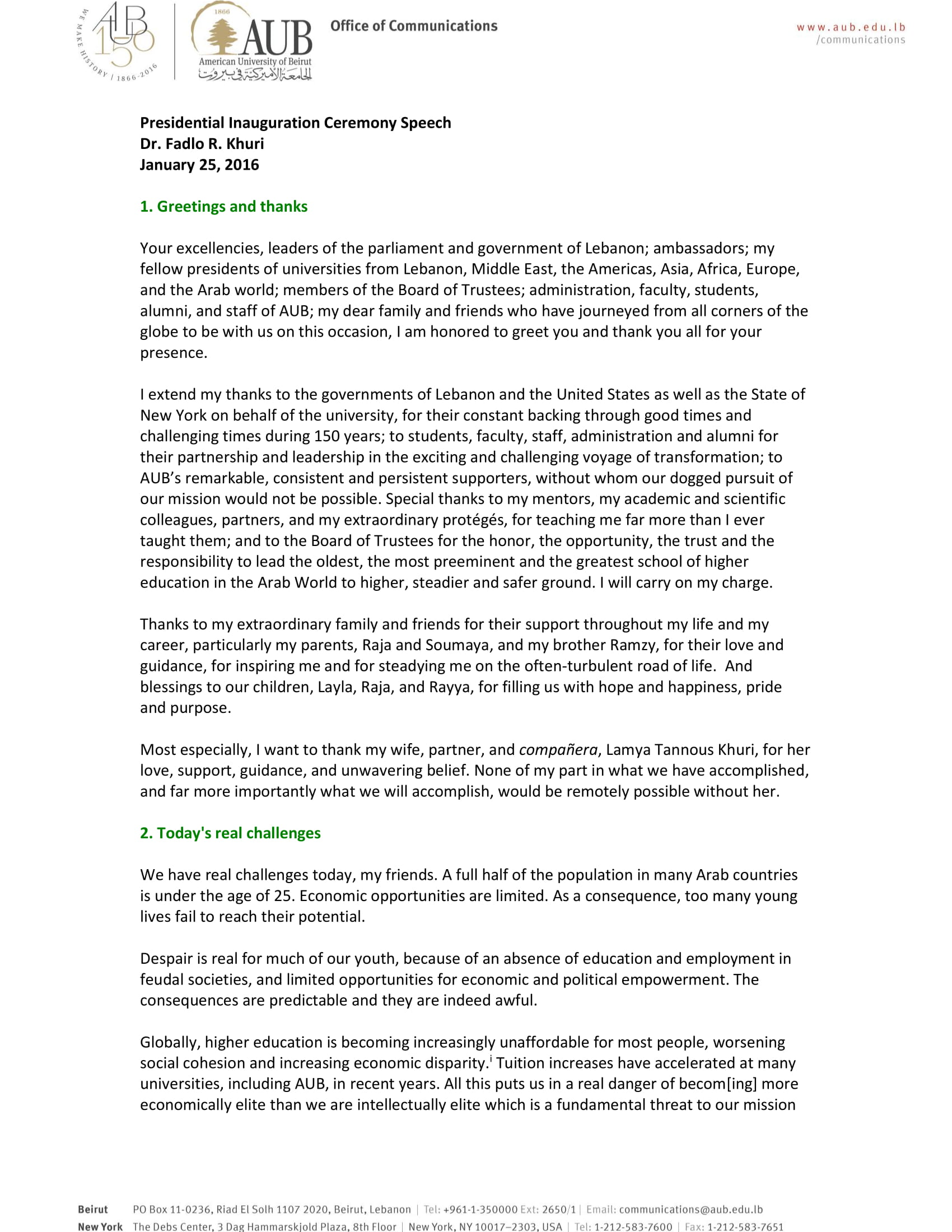
website.aub.edu.lb
Details
File Format
PDF
Size: 372 KB
Attorney General Inaugural Remarks Example
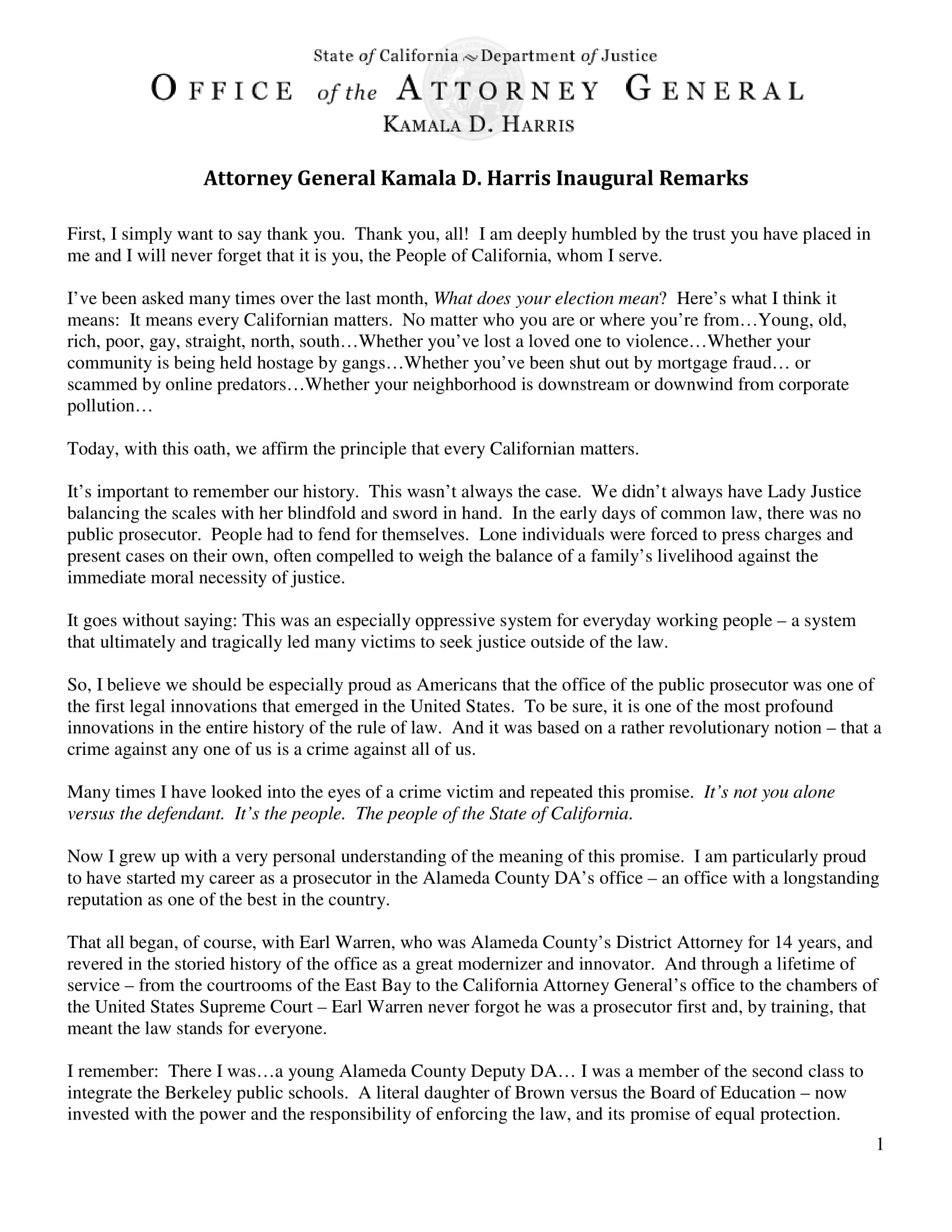
oag.ca.gov
Details
File Format
PDF
Size: 391 KB
Ben Franklin Inaugural Speech Example
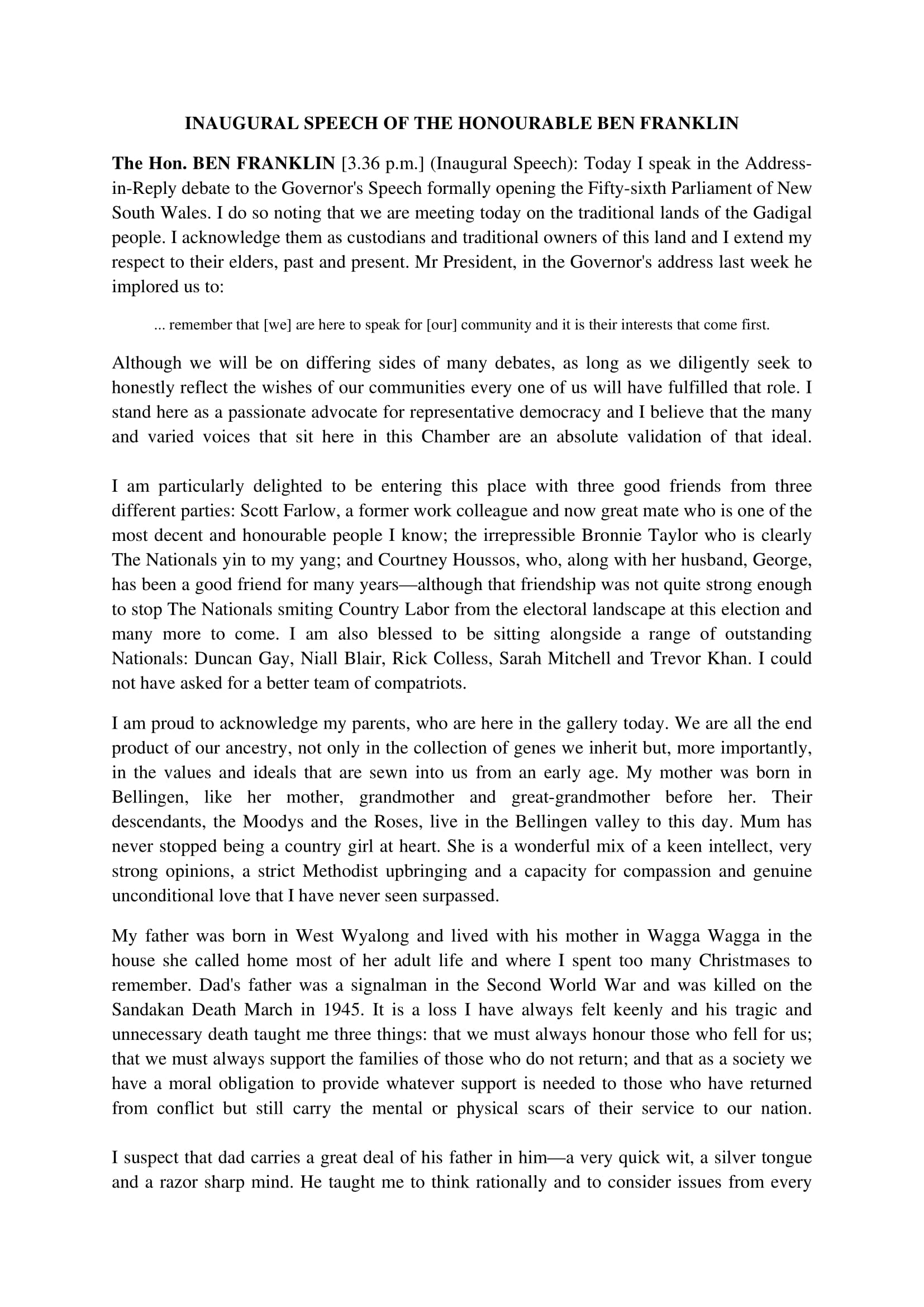
parliament.nsw.gov.au
Details
File Format
PDF
Size: 405 KB
CMA Incoming President Inaugural Speech Example
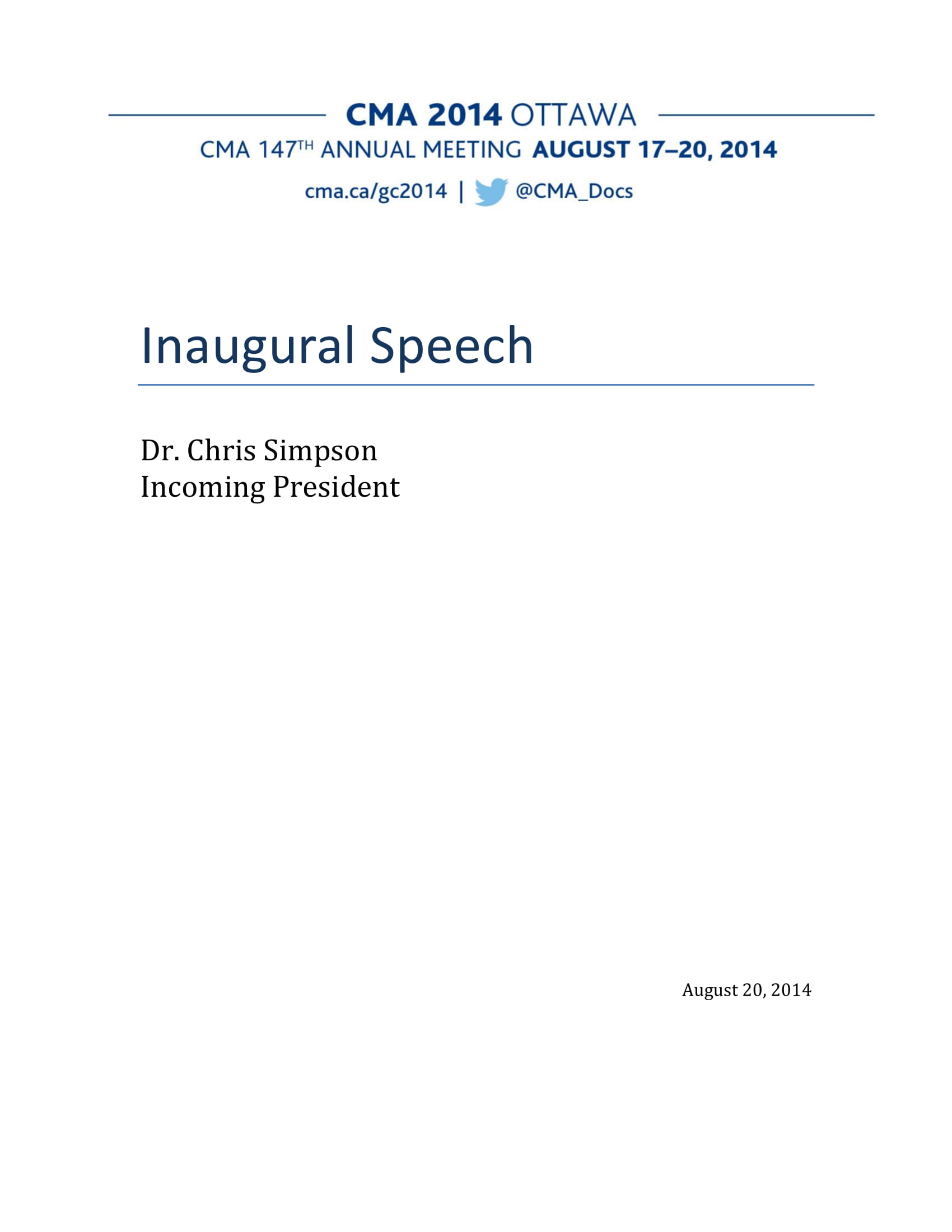
cma.ca
Details
File Format
PDF
Size: 85 KB

